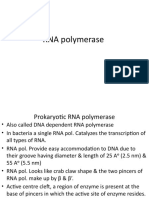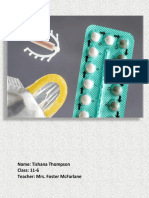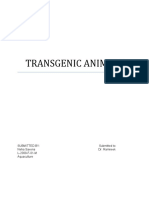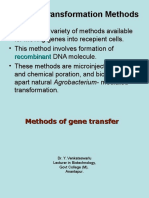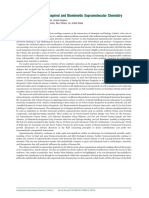Cot Curves
Cot Curves
Uploaded by
Venkateswarlu YadavalliCopyright:
Available Formats
Cot Curves
Cot Curves
Uploaded by
Venkateswarlu YadavalliCopyright
Available Formats
Share this document
Did you find this document useful?
Is this content inappropriate?
Copyright:
Available Formats
Cot Curves
Cot Curves
Uploaded by
Venkateswarlu YadavalliCopyright:
Available Formats
adapted from Roger Meisfeld, University of Arizona
Denaturation and Renaturation of Nucleic Acid Polymers The relative amount of single- or double-stranded DNA in solution can be experimentally determined using spectrophotometery to measure ultraviolet light absorbance at a wavelength of 260 nanometers (OD260). The aromatic bases in DNA are less accessible to ultraviolet light in the double-stranded, compared to singlestranded form, which creates a measurable difference in the observed OD260. Using this empirical difference in absorbance, it is possible to observe the effect of temperature on DNA structure by monitoring OD260 over a range of temperature range. The temperature at which 50% of the DNA is denatured is called the Tm or transition temperature.
adapted from Roger Meisfeld, University of Arizona
The Transition Temperature (Tm) of a nucleic acid duplex is strongly effected by three factors; 1) Base composition 2) Duplex length 3) Ionic strength of the solution Two molecular genetic applications where extent of duplex formation is an important consideration are the use of short oligonucleotides in hybridization reactions, and heteroduplex formations between molecules that are less than 100% complementary. The use of homologous, but not identical, DNA molecules in hybridization reactions is common when sequence divergence exists between two genes, for example, across species or among members of a related gene family. The reverse of nucleic acid denaturation is renaturation, also referred to as reassociation or hybridization. This bimolecular process is most effected by - temperature - ionic strength, - molar concentration of the two complementary strands - reaction time - denaturing agents such as formamide or urea which lower the Tm - dextran sulfate which increases the rate of reassociation
adapted from Roger Meisfeld, University of Arizona
Cot Curves The term Cot is used to describe the kinetics of hybridization between two nucleic strands in solution and is defined by the product of [nucleic acid] x (time). Put simply, when the concentration of two complementary strands in a solution is high, then it takes a shorter time for hybridization to occur than it does when one or both of the strands are present at a low concentration. Cot curves plot percent reassociation versus Cot (mole secs/liter), and are used to measure the sequence complexity of DNA samples . DNA from organisms with small genomes have low sequence complexity and reassociate at much lower Cot values, than do denatured DNA samples from more complex organisms.
adapted from Roger Meisfeld, University of Arizona
Factors that effect the denaturation and renaturation of nucleic acid duplexes.
Parameter
Effect on Tm
Effect on rate of renaturation
base composition
increase Tm with increase %GC
no effect
hybrid length
<150 bp; increase Tm with increase length >500 bp; no effect
increase rate with increase length
ionic strength
increase Tm with increase [Na ]
+
optimal at 1.5M Na
%bp mismatch
decrease Tm with increase %mismatch
decrease rate with increase %mismatch increase rate with increase [DNA]
DNA concentration
no effect
denaturing agents
decrease Tm with increase [formamide], [urea]
optimal at 50% formamide
temperature
not applicable
optimal at 20C below Tm
You might also like
- BIOL 200 Molecular Biology Lecture NotesDocument44 pagesBIOL 200 Molecular Biology Lecture NotesDantong JiaNo ratings yet
- TranscriptionDocument70 pagesTranscriptionkhan aishaNo ratings yet
- Invertebrate Zoology 5th EditionDocument2 pagesInvertebrate Zoology 5th EditionAsad Asad50% (2)
- Quantification of DNADocument3 pagesQuantification of DNAMahathir Mohmed100% (14)
- The Double Helix: Film Activity Student HandoutDocument4 pagesThe Double Helix: Film Activity Student HandoutMatthew Spencer HoNo ratings yet
- Unit Vi: Storage and Expression of Genetic Information DNA Structure, Replication, and Repair Qingsong WangDocument30 pagesUnit Vi: Storage and Expression of Genetic Information DNA Structure, Replication, and Repair Qingsong WangasaadsarfrazNo ratings yet
- Lecture 1 Notes - MITx - 7.28.1x Molecular Biology - DNA Replication and RepairDocument15 pagesLecture 1 Notes - MITx - 7.28.1x Molecular Biology - DNA Replication and RepairNaresh Prasad Sapkota0% (1)
- Concepts of Genetics Chapter 10 SlideDocument85 pagesConcepts of Genetics Chapter 10 SlideUmutFerhatBaşpınarNo ratings yet
- Bio Project-Polymerase Chain ReactionDocument21 pagesBio Project-Polymerase Chain ReactionS.AbiniveshNo ratings yet
- Chemical and Physical Properties of Nucleic AcidsDocument6 pagesChemical and Physical Properties of Nucleic AcidsSherlock Wesley ConanNo ratings yet
- TranscriptionDocument10 pagesTranscriptionHardik ManekNo ratings yet
- Enzymes Used in RDT Corrected Version EditedDocument43 pagesEnzymes Used in RDT Corrected Version EditedYuppie RajNo ratings yet
- Transgenic AnimalsDocument13 pagesTransgenic AnimalsSamunderSinghSinghraNo ratings yet
- Dna SupercoilingDocument16 pagesDna SupercoilingrainabtNo ratings yet
- Molecular Basis of Inheritance, Class 12, Cbse NotesDocument33 pagesMolecular Basis of Inheritance, Class 12, Cbse NotesSubho Bhattacharya60% (5)
- Hyperchromic EffectDocument7 pagesHyperchromic EffectvictorNo ratings yet
- Blotting TechniqueDocument34 pagesBlotting TechniqueUmair100% (2)
- 02-Nucleic Acids - Structure and FunctionDocument70 pages02-Nucleic Acids - Structure and FunctionBerru VardarNo ratings yet
- RNA PolymeraseDocument14 pagesRNA PolymeraseKanaka lata Soren100% (1)
- Cot CurveDocument16 pagesCot CurveVidyasagar Deshpande100% (1)
- Genetic Mapping and Interference and CoincidenceDocument17 pagesGenetic Mapping and Interference and Coincidence62 Renuga S100% (1)
- Eukaryotic Transcription Factors PDFDocument2 pagesEukaryotic Transcription Factors PDFRyanNo ratings yet
- Pulse Chase ExperimentDocument7 pagesPulse Chase ExperimentNikhil Govind Bharambe50% (2)
- CBSE Class 12 Biology Revision Notes Chapter 6 Molecular Basis of InheritanceDocument10 pagesCBSE Class 12 Biology Revision Notes Chapter 6 Molecular Basis of InheritancesahanaNo ratings yet
- Anterior Posterior Axis Patterning in DrosophilaDocument4 pagesAnterior Posterior Axis Patterning in DrosophilaSuresh Babu TNo ratings yet
- Principles of Inheritance and Variation-NotesDocument7 pagesPrinciples of Inheritance and Variation-NotesVaibhav ChauhanNo ratings yet
- Ramachandran PlotDocument18 pagesRamachandran PlotAnogh Siva100% (5)
- DNA ReplicationDocument16 pagesDNA ReplicationStephen Moore100% (1)
- Organisation of Eukaryotic ChromosomesDocument48 pagesOrganisation of Eukaryotic Chromosomesstevensb05591% (23)
- Photoreceptors Part 1Document103 pagesPhotoreceptors Part 1rogini980% (1)
- Sex DeterminationDocument14 pagesSex DeterminationAdri ChakraNo ratings yet
- Molecular Basis of InheritanceDocument83 pagesMolecular Basis of InheritanceKeerthi Sagar100% (1)
- Principles of Protein StructureDocument75 pagesPrinciples of Protein StructureJoel Amoni100% (1)
- Replication, Transcription, Translation, Mutation HWDocument20 pagesReplication, Transcription, Translation, Mutation HWtahamidNo ratings yet
- 09022018094950-Retrogressive Metamorphosis in HerdmaniaDocument5 pages09022018094950-Retrogressive Metamorphosis in HerdmaniaBaikuntha SabarNo ratings yet
- Molecular Basis of Inheritance: By: Dr. Anand ManiDocument130 pagesMolecular Basis of Inheritance: By: Dr. Anand ManiIndu Yadav100% (3)
- Selection of Recombinant ClonesDocument2 pagesSelection of Recombinant ClonesKV Deepika100% (1)
- Replication in EukaryotesDocument8 pagesReplication in EukaryotesnaliniNo ratings yet
- Experiment No 6: Estimation of Concentration of RNA by Orcinol MethodDocument19 pagesExperiment No 6: Estimation of Concentration of RNA by Orcinol MethodVineet Kumar ThakurNo ratings yet
- S1 Nuclease MappingDocument11 pagesS1 Nuclease Mappingstevensb055100% (1)
- Organism and Population - CBSE Biology Class XII Notes - Cbsebiology4u PDFDocument14 pagesOrganism and Population - CBSE Biology Class XII Notes - Cbsebiology4u PDFabhiNo ratings yet
- Construction of Genomic LibraryDocument16 pagesConstruction of Genomic Librarysivagurunathan.P80% (5)
- Lampbrush ChromosomeDocument13 pagesLampbrush Chromosomestevensb05586% (7)
- String DatabaseDocument10 pagesString DatabaseAnirudh PottipalliNo ratings yet
- DC2 Unit1 MetamerismDocument7 pagesDC2 Unit1 Metamerismobama.official.sexyNo ratings yet
- Chapter 19Document42 pagesChapter 19Dr. Manish KumarNo ratings yet
- Birth Control ProjectDocument16 pagesBirth Control ProjectTishana Thompson100% (1)
- Chromosomal AberrationDocument7 pagesChromosomal AberrationANSA PRIYADARSHINI0% (1)
- Molecular MarkersDocument4 pagesMolecular MarkersKai RobinsonNo ratings yet
- TRANSGENIC ANIMALS PDocument12 pagesTRANSGENIC ANIMALS PNehaNo ratings yet
- DNA PackagingDocument25 pagesDNA PackagingHoor Ul Ain Rounaq100% (2)
- A, B and Z DnaDocument24 pagesA, B and Z DnaUtkarsh Sharma100% (1)
- Parasitic Adaptation PDFDocument6 pagesParasitic Adaptation PDFmubarik Hayat50% (2)
- Temperature Gradient Gel Electrophoresis-SenDocument7 pagesTemperature Gradient Gel Electrophoresis-Sensivagurunathan.P100% (2)
- Chapter 7 Protoplast CultureDocument76 pagesChapter 7 Protoplast Culturerajiv pathakNo ratings yet
- RFLP & RapdDocument25 pagesRFLP & RapdBalaji Prasanna Kumar100% (1)
- Cloning Vectors: Types & CharacteristicsDocument18 pagesCloning Vectors: Types & Characteristicsayush100% (1)
- Dna FingerprintingDocument27 pagesDna FingerprintingDivya MittalNo ratings yet
- DNA Fingerpting PDFDocument27 pagesDNA Fingerpting PDFArghya Paul100% (1)
- Nucleic Acids.Document7 pagesNucleic Acids.Mujthaba AdmaniNo ratings yet
- Unit 5 Developmental Biology CSIR UGC NET Life Sciences PDFDocument5 pagesUnit 5 Developmental Biology CSIR UGC NET Life Sciences PDFjaspreet kaurNo ratings yet
- Genome ComplexityDocument24 pagesGenome ComplexityAbhishek KumarNo ratings yet
- Bio 101Document31 pagesBio 101SunflowerNo ratings yet
- Biochemistry Notes 04 - 04 - 2024Document6 pagesBiochemistry Notes 04 - 04 - 2024Vinay Kumar Reddy PNo ratings yet
- s15 Miller Chap 8b LectureDocument19 pagess15 Miller Chap 8b LectureKartika Fitri100% (1)
- Hussain Sagar Lake PollutionDocument5 pagesHussain Sagar Lake PollutionVenkateswarlu YadavalliNo ratings yet
- Life Certificate 2017Document6 pagesLife Certificate 2017Venkateswarlu YadavalliNo ratings yet
- 3 Plant Transformation MethodsDocument31 pages3 Plant Transformation MethodsVenkateswarlu Yadavalli100% (2)
- Applications of RDNA Technology in AgricultureDocument1 pageApplications of RDNA Technology in AgricultureVenkateswarlu YadavalliNo ratings yet
- Industrial MicroorganismsDocument7 pagesIndustrial MicroorganismsriddhisnewworldNo ratings yet
- Cell Membrane Permeability Lab Guide and WorksheetDocument10 pagesCell Membrane Permeability Lab Guide and WorksheetVenkateswarlu YadavalliNo ratings yet
- Recombinant DNA TechnologyDocument27 pagesRecombinant DNA TechnologyVenkateswarlu YadavalliNo ratings yet
- Advocates in HyderabadDocument2 pagesAdvocates in HyderabadVenkateswarlu YadavalliNo ratings yet
- Biotech GuideDocument140 pagesBiotech Guidehoracio100% (12)
- Transcription: RNA Synthesis: Prokaryotes EukaryotesDocument29 pagesTranscription: RNA Synthesis: Prokaryotes EukaryotesVenkateswarlu YadavalliNo ratings yet
- AP State UniversitiesDocument1 pageAP State UniversitiesVenkateswarlu YadavalliNo ratings yet
- CarbohydratesDocument93 pagesCarbohydratesVenkateswarlu Yadavalli100% (2)
- AP State UniversitiesDocument6 pagesAP State UniversitiesVenkateswarlu YadavalliNo ratings yet
- Plant Tissue CultureDocument17 pagesPlant Tissue CultureVenkateswarlu Yadavalli100% (1)
- Molecular Biology Lecture NotesDocument7 pagesMolecular Biology Lecture NotesChristineNo ratings yet
- I. Extracting DNA From Your Cells: Why Am I Adding Detergent?Document6 pagesI. Extracting DNA From Your Cells: Why Am I Adding Detergent?Jacob SmithNo ratings yet
- Differences Between DNA and RNADocument2 pagesDifferences Between DNA and RNAmonisha100% (1)
- DNA Structure - A-, B - and ZDocument7 pagesDNA Structure - A-, B - and ZAlexandraNo ratings yet
- PeakForce Tapping - B080-RevA2Document8 pagesPeakForce Tapping - B080-RevA2saumyazzNo ratings yet
- DNA Conformation and Transcription Pag. 145 SupercoilingDocument215 pagesDNA Conformation and Transcription Pag. 145 SupercoilingDiegoNo ratings yet
- Making DNA Models Lesson PlanDocument3 pagesMaking DNA Models Lesson PlanAnnabel LeeNo ratings yet
- Monday Test 8 With ExplanationDocument10 pagesMonday Test 8 With Explanationbiotecnika_testNo ratings yet
- Chapter 4 THE BIOLOGICAL AND ENVIRONMENTAL CAUSES OF DEVELOPMENTAL DISABILITIESDocument87 pagesChapter 4 THE BIOLOGICAL AND ENVIRONMENTAL CAUSES OF DEVELOPMENTAL DISABILITIESChristy100% (3)
- Dna SupercoilingDocument16 pagesDna SupercoilingrainabtNo ratings yet
- Thesis AI - Carlos Fenollosa BielsaDocument89 pagesThesis AI - Carlos Fenollosa BielsaoxfordatenasNo ratings yet
- The Double Helix - Personal View Crick Nature 1974Document4 pagesThe Double Helix - Personal View Crick Nature 1974Abhay KumarNo ratings yet
- BT 301 Short Question Mid TermDocument11 pagesBT 301 Short Question Mid TermAlishba khan100% (2)
- Exam1 S14Document33 pagesExam1 S14Asad Javed MehmoodNo ratings yet
- CH 29Document32 pagesCH 29IshNo ratings yet
- DNA StructureDocument15 pagesDNA StructureOhhh OkayNo ratings yet
- Structure of DNA: DNA Is Composed of Four Types of NucleotidesDocument4 pagesStructure of DNA: DNA Is Composed of Four Types of NucleotidesMarcelaVillanuevaNo ratings yet
- Philosophy of ScienceDocument8 pagesPhilosophy of ScienceBenjamin MariNo ratings yet
- Nadrian C. Seeman - From Genes To Machines: DNA Nanomechanical DevicesDocument7 pagesNadrian C. Seeman - From Genes To Machines: DNA Nanomechanical DevicesLpeo23No ratings yet
- Druid Dracula - Post Case QuestionsDocument7 pagesDruid Dracula - Post Case QuestionsKory TurnerNo ratings yet
- A Primer To Scaffolded Dna OrigamiDocument9 pagesA Primer To Scaffolded Dna OrigamiJulián Zapata CardonaNo ratings yet
- Structure of DNA: Teacher Notes and AnswersDocument4 pagesStructure of DNA: Teacher Notes and Answersyawahab100% (1)
- Bioinspired and Biomimetic Supramolecular ChemistryDocument653 pagesBioinspired and Biomimetic Supramolecular ChemistryFGHNo ratings yet
- Clones / Synthetics / Organic RobotoidsDocument37 pagesClones / Synthetics / Organic RobotoidsStephen J. Roberts100% (2)
- Download ebooks file Bioinformatics for Beginners Genes Genomes Molecular Evolution Databases and Analytical Tools 1st Edition Supratim Choudhuri all chaptersDocument67 pagesDownload ebooks file Bioinformatics for Beginners Genes Genomes Molecular Evolution Databases and Analytical Tools 1st Edition Supratim Choudhuri all chapterssorcicomin0t100% (6)


















